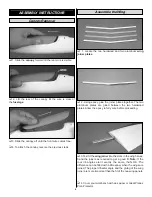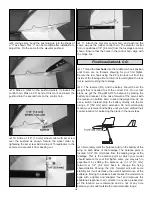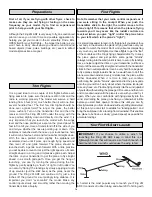
of a thermal. The easiest way to lose altitude is to apply full
rudder and full up elevator. This will put the plane into a tight
spin that will not over stress the airframe but it will enable it
to lose altitude very quickly. This is especially helpful if the
sailplane gets sucked into a cloud or it gets too high to see.
The twirling action will give the sun a better chance of
flashing off of the wing and catching your attention. When
you are high enough and want to leave the thermal, add a
little down trim to pick up some speed and fly 90 degrees to
the direction of the wind. If you are not real high and want to
find another thermal, you may want to look upwind of the last
thermal. The same source that generated this thermal is
probably producing another. Just watch out for “sink” which
is often found behind and between thermals.
As you might expect, with all this air rising, there is also air
sinking. This air is the sailplane pilot’s nightmare and can
really make soaring challenging. “Sink” is usually not as
strong as the thermals in the same area, but it can be very
strong. Downdrafts of many hundreds of feet per minute are
common on a good soaring day. These downdrafts can
make a sailplane look like it is falling out of the air. Because
of this, it is important that you do not let the sailplane get too
far downwind.
When encountering sink, immediately turn and fly 90
degrees to the direction of the wind (towards you if possible).
Apply a little “down elevator” and pick up some speed to get
out of the sink as fast as possible. Every second you stay in
the sink is precious altitude lost.
Slope soaring is a type of flying that is very popular in hilly
regions and along the coasts. This type of soaring is
possible when the wind is blowing directly up a hill or cliff. As
the wind hits the slope it is forced up, producing lift which
can be utilized by real sailplanes, hang gliders, birds and
even model sailplanes. To be able to slope soar, you need a
slope with a smooth piece of land (or water) out in front of it
and a breeze blowing pretty close to straight up the slope.
The higher and steeper the hill or cliff is, the better. Also, the
larger and smoother the land out in front is, the better. The
air flowing along that hits the hill and is forced up can
generate a very large area of lift. Behind the hill is a large
area of turbulent air that can be very dangerous to try to fly
in. The faster the wind is blowing, the stronger the lift and
turbulence will be. To fly off a slope, stand near the edge and
throw the sailplane (nose down) into the wind. As the
sailplane flies out into the “band” of lift it will begin to gain
altitude. Turn and fly parallel to the slope and make all of
your turns into the wind (especially when you are close to
the slope).You will be surprised at the altitude you can gain
just from slope lift. Thermals will often be “popped loose” by
these slopes. If you catch a thermal and follow it downwind,
be very careful to stay high enough to make it back to the
slope without flying through the turbulent air behind the
slope. If you don’t have enough altitude you may want to
land a good distance behind the slope if possible to avoid
this turbulent air.
Landings can be very tricky on some slopes. On gentle slopes
you can often fly very close to the top of the slope and “slide”
into the top of the slope without encountering any turbulent
air. On steeper slopes you may have to be a little more
aggressive to get the plane out of the lift. In any case it is a
good idea to plan your landing before launching your plane.
Have a ball! But always stay in control and fly in a
safe manner.
GOOD LUCK AND GREAT FLYING!
Make a copy of this identification tag and put it on or
inside your model.
Great Planes ElectriFly
™
Mini 4-Channel FM Receiver
Worried about receiver-transmitter compatibility? Hook up
an economical ElectriFly 4-channel Mini FM receiver, and it
will automatically select the circuitry compatible with your
Futaba, JR
®
, Hitec
®
, or Airtronics
®
“Z” radios. Innovative
circuitry makes it a match for most popular systems – the
size, range, and low 10-gram weight make it perfect for
today’s small electrics. Designed for park, slow and indoor
flyers, the receiver features SMT components for maximum
dependability. Available in high- and low-band versions on
72MHz. Requires a short, single-conversion Futaba FM
crystal, available separately. 1-year warranty. GPML0044
ALSO AVAILABLE FROM
GREAT PLANES
Slope Landings
Slope Soaring

































